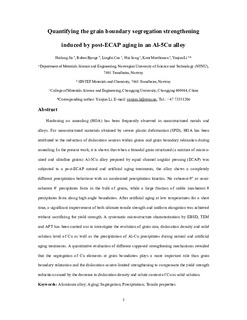Quantifying the grain boundary segregation strengthening induced by post-ECAP aging in an Al-5Cu alloy
Journal article
Submitted version
Permanent lenke
http://hdl.handle.net/11250/2562599Utgivelsesdato
2018Metadata
Vis full innførselSamlinger
- Institutt for materialteknologi [2544]
- Publikasjoner fra CRIStin - NTNU [37963]
Sammendrag
Hardening on annealing (HOA) has been frequently observed in nanostructured metals and alloys. For nanostructured materials obtained by severe plastic deformation (SPD), HOA has been attributed to the reduction of dislocation sources within grains and grain boundary relaxation during annealing. In the present work, it is shown that when a bimodal grain structured (a mixture of micron-sized and ultrafine grains) Al-5Cu alloy prepared by equal channel angular pressing (ECAP) was subjected to post-ECAP natural and artificial aging treatments, the alloy shows a completely different precipitation behavior with an accelerated precipitation kinetics. No coherent θ'' or semi-coherent θ' precipitates form in the bulk of grains, while a large fraction of stable incoherent θ precipitates form along high angle boundaries. After artificial aging at low temperatures for a short time, a significant improvement of both ultimate tensile strength and uniform elongation was achieved without sacrificing the yield strength. A systematic microstructure characterization by EBSD, TEM and APT has been carried out to investigate the evolution of grain size, dislocation density and solid solution level of Cu as well as the precipitation of Al-Cu precipitates during natural and artificial aging treatments. A quantitative evaluation of different supposed strengthening mechanisms revealed that the segregation of Cu elements at grain boundaries plays a more important role than grain boundary relaxation and the dislocation source-limited strengthening to compensate the yield strength reduction caused by the decrease in dislocation density and solute content of Cu in solid solution.
